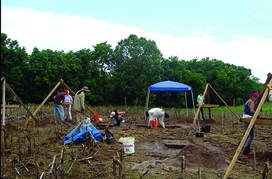Group goes back in time, again
Brad Logan digs for prehistoric knowledge in Leavenworth County
Just as prehistoric peoples kept returning to a riverbank in Leavenworth County, so too do Brad Logan and his troop of anthropology students.
 The Kansas Archaeological Field School takes place in even years. Through June 27, Logan and 10 students were back in the Stranger Creek watershed, this time along Nine Mile Creek.
The Kansas Archaeological Field School takes place in even years. Through June 27, Logan and 10 students were back in the Stranger Creek watershed, this time along Nine Mile Creek.
"I've been back there every year since 2001, when a flood exposed the floor of a late prehistoric house," said Logan, a research associate professor in the department of sociology, anthropology and social work. The late prehistoric era ranged from AD 900 to 1500.
As a doctoral student Logan based his dissertation on the watershed's trove of tools, pottery and other relics of diverse prehistoric populations, some as young as 800 years old, others stretching beyond 5000 B.C.
The work he and his students pursued this summer could result in a National Register of Historic Places listing exclusive to prehistoric sites in the Stranger Creek basin.
Logan attributes the area's enduring popularity among Stone Age peoples in part to readily available, high-quality chert and to a landform that was rarely flooded, even though it was along the tributaries of a major waterway.
"It's called Toronto chert, after the limestone in which it formed, and it attracted Stone Age people throughout the watershed and adjacent areas," Logan said. "A good flintknapper can shape it into any sort of tool.
"And the tributary valleys, during times of flood, have these nice terraces, or a ‘second bottom,' that would generally remain flood free."
Stranger Creek is the last major watershed to empty into the Kansas River before it joins the Missouri River, and the area has always formed a natural boundary, Logan said. Centuries ago, it marked the transition between the wooded East and grassland West.
"It's kind of a frontier area, " he said. "You can almost see people coming out of the woods and seeing the prairie and saying, ‘I think this is about as far as I want to go.'
"Accounts by travelers across Stranger Creek, including Francis Parkman and Horace Greeley, show how they were struck by the contrast in vegetation," Logan said.
"So you can imagine that Native Americans, whose livelihoods depended on the varied resources of these major plant communities, would have been impressed as well."
Though many groups occupied the area over thousands of years, Logan is particularly interested in the Steed-Kisker culture, whose members built the house the K-State team studied. Logan hoped that this summer's dig would recover evidence of those people, whose territory centered on the Missouri River in the modern Kansas City area.
"Some archaeologists had suggested that Steed-Kisker groups hadn't crossed the Missouri, that they stayed in northwest Missouri," he said.
Among this summer's finds were a projectile point-knife that is among the oldest found in the region (about 8000-5000 BC) and corner-notched arrow points that point to occupation by people of the Late Woodland period, AD 500-1000.
In addition to dirt-under-the-fingernails field methods, participating students learned laser surveying, topographical map interpretation and even the right way to walk around a site. They documented it for a geographic information system database maintained by the Kansas Geological Survey.
Lectures by Logan and guests included the region's prehistory and general geographic information science. n
Photo: Brad Logan leads this summer's Kansas Archaeological Field School near a Kansas River tributary. "I've been back there every year since 2001, when a flood exposed the floor of a late prehistoric house," Logan said.